Facts and summary, V-E Day, also written VE Day: V-E Day stands for Victory in Europe Day. In the Soviet Union it was called simply Victory Day and still goes by that name in states of the former USSR. Some early reports in the West also called the day V-Day, but V-E was more accurate, as the war still continued in the Pacific Theater. Today in France the day is called World War II Victory Day.
V-E Day was observed on May 8, 1945, in Great Britain, Western Europe, the United States and Australia, and on May 9 in the Soviet Union and New Zealand.
V-E Day commemorates the unconditional surrender of Nazi Germany to the Allied forces in 1945, ending World War II in Europe. With their power-mad Fuhrer, Adolf Hitler, dead by his own hand, German military leaders signed surrender documents at several locations in Europe on May 7, capitulating to each of their victorious foes. Germany’s partner in fascism, Italy, had switched sides in 1943, though many Italians continued to fight alongside their German comrades in Italy.
Significance of V-E Day
For just over five years and eight months a war had been raging in Europe that began with Germany’s invasion of Poland on September 1, 1939. By the summer of 1941, the military of Germany’s fascist dictator Adolf Hitler had conquered or subdued virtually all of Europe from Spain’s eastern border to the western border of the Soviet Union. Italy, under the control of the fascist Benito Mussolini, was allied with Germany, and the two nations fought against the British (and later the Americans) in North Africa and Italy.
While still at war with Great Britain Hitler invaded the USSR on June 22, 1941, and on December 11 of that year he declared war on the United States of America, to honor a mutual support pact he had signed with Imperial Japan. The “European War” and the war the Japanese had been fighting in Asia and the Southwest Pacific were now a global conflict — the Second World War. Upon entering the war in December 1941, the United States agreed on a “Europe first” strategy: concentrate on defeating Germany, Italy and their satellites rather than focusing the bulk of men and resources on the war in the Pacific.
V-E Day, therefore, marked a major milestone for the Allies but did not end the war — as Allied governments pointedly reminded their citizens. Attention turned to finishing the war against Imperial Japan. Continue reading to see how the news of victory in Europe was received in Allied nations around the world and by front-line troops in Europe and the Asia-Pacific theaters.
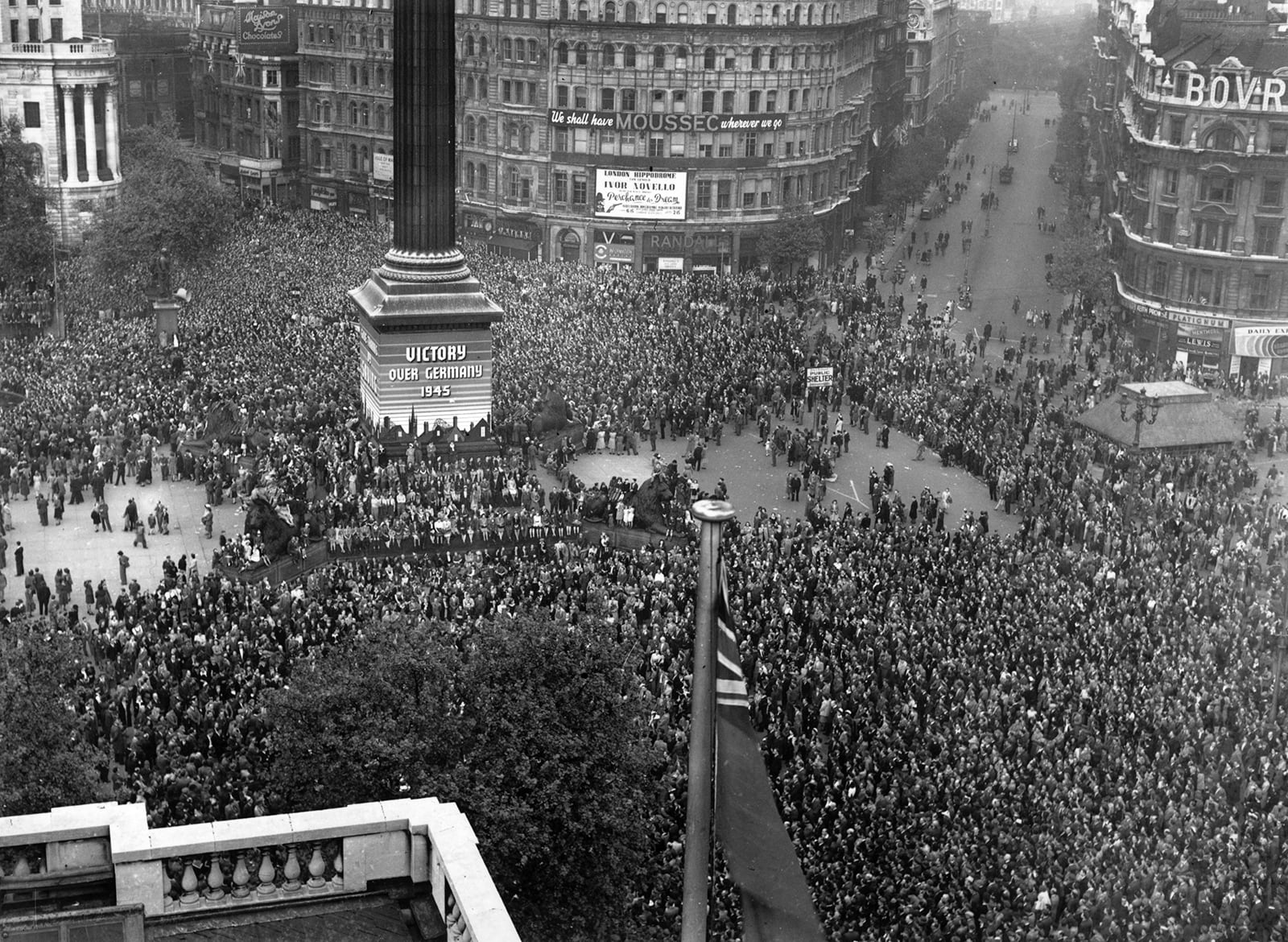
V-E Day 1945 in the British Isles
In London, British Prime Minister Winston Churchill learned of the German surrender at 7:00 a.m. on May 7, but no official announcement was made until 7:40 that evening. The Soviet Union’s premier Josef Stalin wanted to keep to the agreed-upon schedule of holding off on announcements until May 9. Finally, Churchill growled that he was not going to give the Communist leader the satisfaction of holding up the news that was already spreading. (Germany had already informed its people of the surrender.)
The understated official announcement from Britain’s Ministry of Information said simply, “In accordance with arrangements between the three great powers, tomorrow, Tuesday (May 8), will be treated as Victory in Europe Day and will be regarded as a holiday.”
Tens of thousands rushed into the streets of London and continued celebrating until heavy rains arrived around midnight that night.
On V-E Day the next day, celebrations continued as best they could with rationing still in place. The Home Office declared, “Bonfires will be allowed, but the government trusts that only material with no salvage value will be used.” The Board of Trade lifted rationing of cloth just a smidgen: “Until the end of May you may buy cotton bunting without coupons, as long as it is red, white or blue, and does not cost more than one shilling and three pence a square yard.”
English novelist Mollie Panter-Downes wrote in a letter that ran in New Yorker Magazine on May 19 that even dogs trotted along wearing immense tricolored bows, and “American sailors and laughing girls formed a conga line down the middle of Piccadilly.” Others, however, noted that many faces in the crowds were glum, too deeply affected by the war to be jubilant.
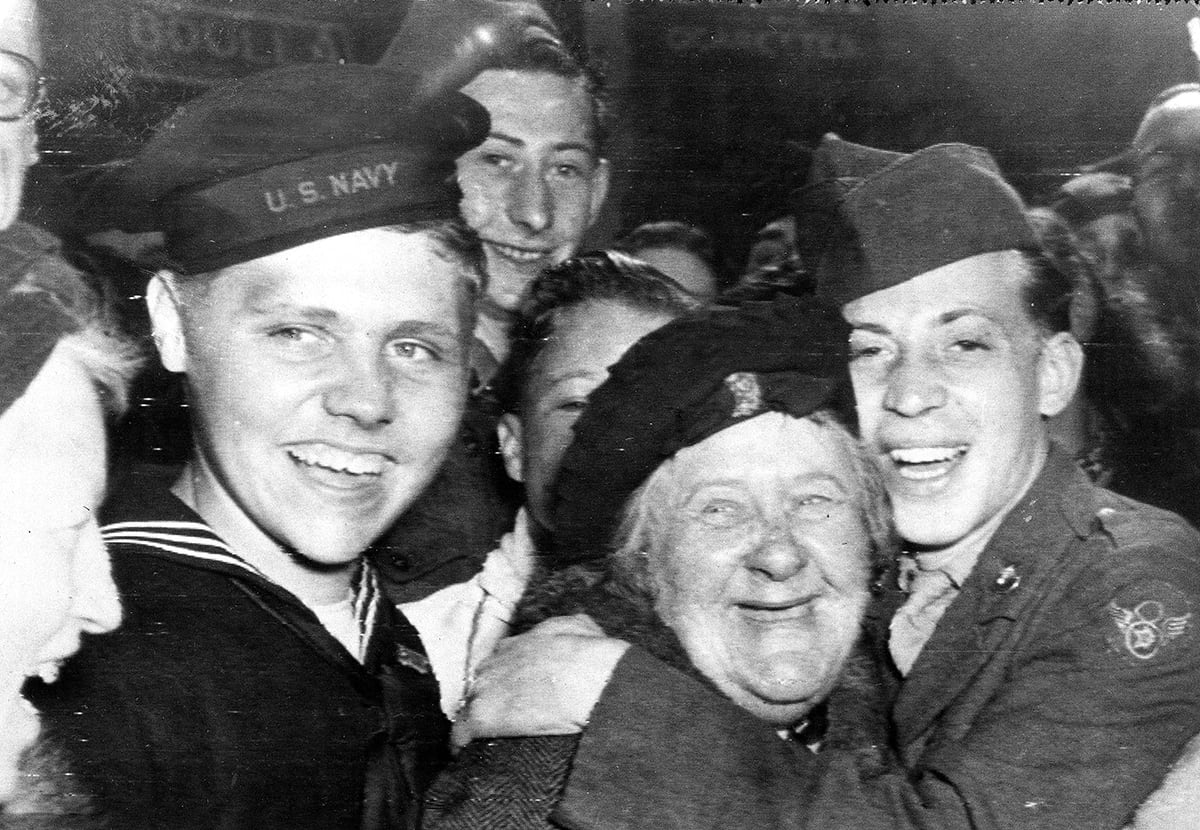
Churchill, greeted with cries of, “Winnie, Winnie,” from the crowds, announced Britons “may allow ourselves a brief period of rejoicing. Advance Britannia. Long live the cause of freedom! God save the King!” Then it would be time to get back to the work of finishing the war against Japan.
In Scotland, the people joined in their national dance, the “eightsome reel,” and enjoyed nighttime illumination that had been forbidden for five years when all of Great Britain was “blacked out” to keep from helping German bombers find targets.
In Wales, street parties broke out. Sugar had been sharply rationed during the war and would not be available in any quantity for some time to come, but the Welsh used whatever they had managed to save to create sweets for the children. Long tables with the treats were set up in the streets; the young ones also enjoyed a two-day holiday from school.
In Northern Ireland, bunting and Union Jack flags hung from the houses, flying above spontaneous celebrations. As in Wales and elsewhere, whatever reserves of sugar could be found were used to bake desserts and special treats. (The Republic of Ireland remained neutral during the war. Some 5,000 men of its Irish Defense Force who went AWOL in order to enlist elsewhere in the war against the Germans were officially designated as deserters until they were officially pardoned in 2013.)
V-E Day 1945 in Canada
Some 1 million men and women — nearly a tenth of Canada’s population of 11 million — served in the military during the war, and the country was the fourth-largest producer of war materiel. The country emerged from the war with a new level of international respect.
In Toronto, ticker tape and other paper rained down from the windows of businesses and from some Mosquito medium bombers that circled the tops of buildings. The celebrations in the street were led by young people. Toronto’s The Globe and Mail newspaper noted that “The men in uniform were less demonstrative, less exuberant, especially those who wore ribbon and whose eyes told of things that the bobby sox brigade would not have to see.”
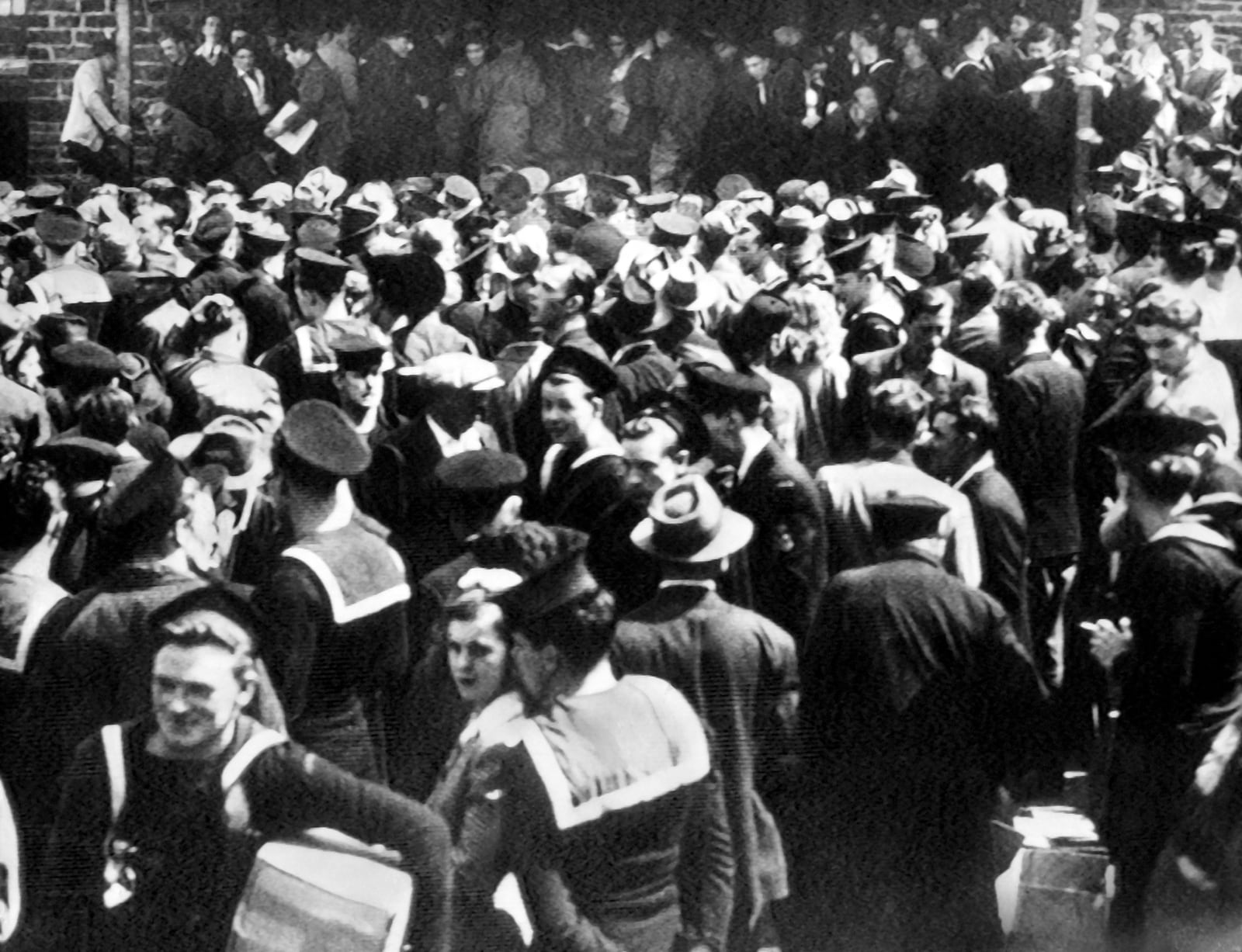
Riots broke out in a few towns. The worse was in the port of Halifax where pubs and liquor stores were ordered to be locked up on V-E Day. What began as a break-in to get drinks at a pub turned into riotous looting, damaging over 550 stores and causing $1 million damage.
V-E Day 1945 in Australia and New Zealand
The Sydney Morning Herald in Australia greeted V-E Day with the question, “Since when has it been customary to celebrate victory halfway through a contest?” The war with Japan had been the great threat to Australia itself, and the country’s sons were still fighting and dying in that war. Accordingly, the mood was more somber than in Europe. On May 9, some 100,000 people attendee a service at the Shrine of Remembrance in Melbourne. Regardless, Australian service personnel overseas joined in the raucous celebrations of whatever country they were in that day.
Headlines announced the victory to New Zealanders on the morning of May 8, but Walter Nash, acting prime minister, refused to allow celebrations until Winston Churchill officially announced the peace from London. That didn’t happen until May 9 at one o’clock in the morning, New Zealand time, so for the most part New Zealanders observed V-E Day on May 9, although there was some spontaneous dancing in the streets. Preparations had been underway for weeks, in part to keep celebrations from getting out of control. Events included speeches, thanksgiving services, and the singing of the national anthems of New Zealand, America and the Soviet Union. A People’s Victory March in Christchurch drew 25,000.
V-E Day 1945 in South Africa
In Cape Town the thousands of celebrants brought traffic to a near-standstill. The Cape Times of the following day wrote, “The gnawing, ceaseless anxiety in many homes for loved ones in danger has vanished like an evil dream.” South Africa was home to many people of German descent, however, and in 1940 the decision to fight as part of the British force against Germany and Italy was not popular with those who supported Hitler’s policies. On V-E Day itself, a group overpowered guards and raided the office of the chief controller in Pretoria.

V-E Day 1945 in France
Charles de Gaulle, who had led the Free French Forces throughout the war, made the official announcement to his people that Germany was defeated and Hitler was dead: ” The war has been won. This is victory. It is the victory of the United Nations and that of France. The German enemy has surrendered to the Allied Armies in the West and East. The French High Command was present and a party to the act of capitulation … Honor to our nation, which never faltered, even under terrible trials, nor gave in to them. Honor to the United Nations, which mingled their blood, their sorrows and their hopes with ours and who today are triumphant with us.”
Church bells rang out to relay his message. Celebrations continued for two days.
Today, V-E Day is known as World War II Victory Day in France. At various times it has been observed on the feast of St. Joan of Arc (May 16), Armistice Day (November 11, marking the end of the First World War), and the second Sunday in May. In 1975, the government announced there would be no official observance of the end of the war, which drew protests from veterans. Following a great deal of public debate, World War II Victory Day became an official national holiday in 1982, observed on May 8.
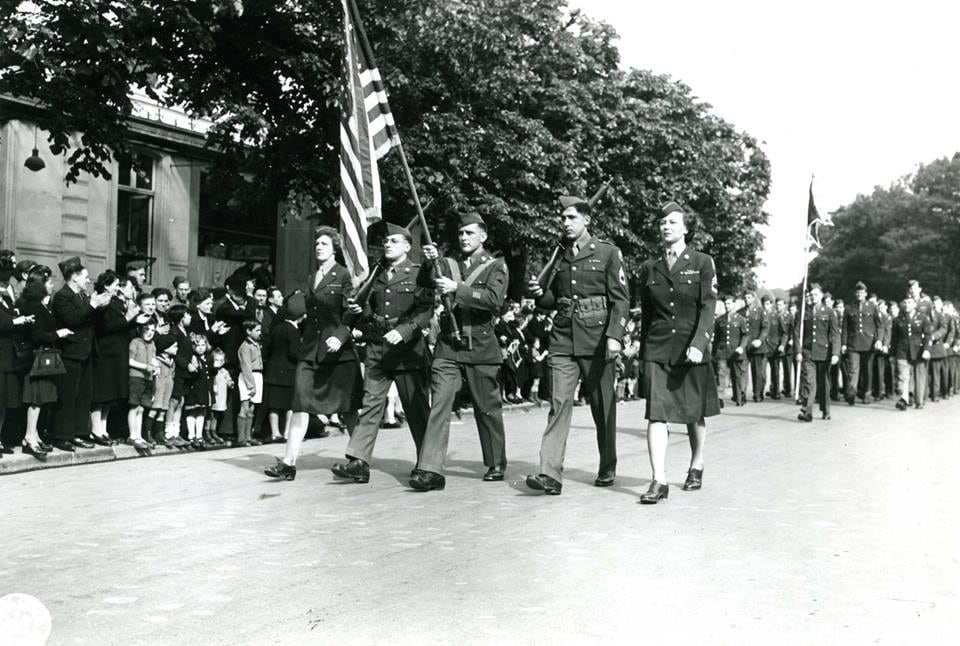
V-E Day in the Low Countries
The Low Countries — Holland, Belgium, Luxembourg — were the first countries invaded by German forces on the way to attack France in May 1940, and most of the vicious fighting of the Battle of the Bulge (December 16, 1944–January 16, 1945) took place in Belgium and Luxembourg.
In Holland, V-E Day arrived just two days short of the fifth anniversary of the day German troops had invaded the country. Prime Minister William Mackenzie King announced the “victory won at so great a price” and reminded citizens that the war against Japan continued. The grateful Dutch joyously swarmed Canadian troop convoys, throwing flowers and sometimes knocking men from their tanks in the enthusiasm to thank them. People too sick to walk were often carried outside to join in the celebration. Dutch flags and orange streamers (for the royal family of the Kingdom of the Netherlands, the House of Orange-Nassau) flew from nearly every house.
It was the beginning months of “Holland’s wild summer of 1945″ — which stood in marked contrast to the “Hunger winter” of 1944-45 when Germans cut off food, coal and medical supplies to the country in retaliation for the Dutch assisting Allied troops.
In Belgium, the old buildings of Brussels that had witnessed so much history in a country known as “the crossroads of Europe” were illuminated by fireworks, spotlights and bonfires as thousands thronged the streets after the news was announced on the evening of May 7. The crowds returned the next day, after thanksgiving services in churches. Britain’s Union Jack and America’s Stars and Stripes were carried along with the black, yellow and red tricolor of Belgium.
The story was much the same in Luxembourg: delirious over the war’s end, citizens swarmed Americans, giving them flowers and drinks of wine.
V-E Day 1945 in the United States
President Harry S Truman announced the victory in Europe to the American people and appointed Sunday, May 13 — Mother’s Day, appropriately enough — a day of prayer for thanksgiving. In part, his announcement said, “Our rejoicing is sobered and subdued by a supreme consciousness of the terrible price we have paid to rid the world of Hitler and his evil band. Let us not forget, my fellow Americans, the sorrow and the heartache which today abide in the homes of so many of our neighbors — neighbors whose most priceless possession has been rendered as a sacrifice to redeem our liberty … If I could give you a single watchword for the coming months, that word is work, work, and more work. We must work to finish the war. Our victory is only half over.”
Many communities attempted to subdue celebrations, wanting to give the occasion the solemnity they felt it deserved and reminding Americans that, as Truman said, “Our victory is only half over.”
Across the country, however, joyous celebrations broke out. Thousands gathered in New York’s Times Square. New Orleans took on the appearance of Mardi Gras, with people dancing in the streets. Church bells rang out the glorious news in small towns and major cities.
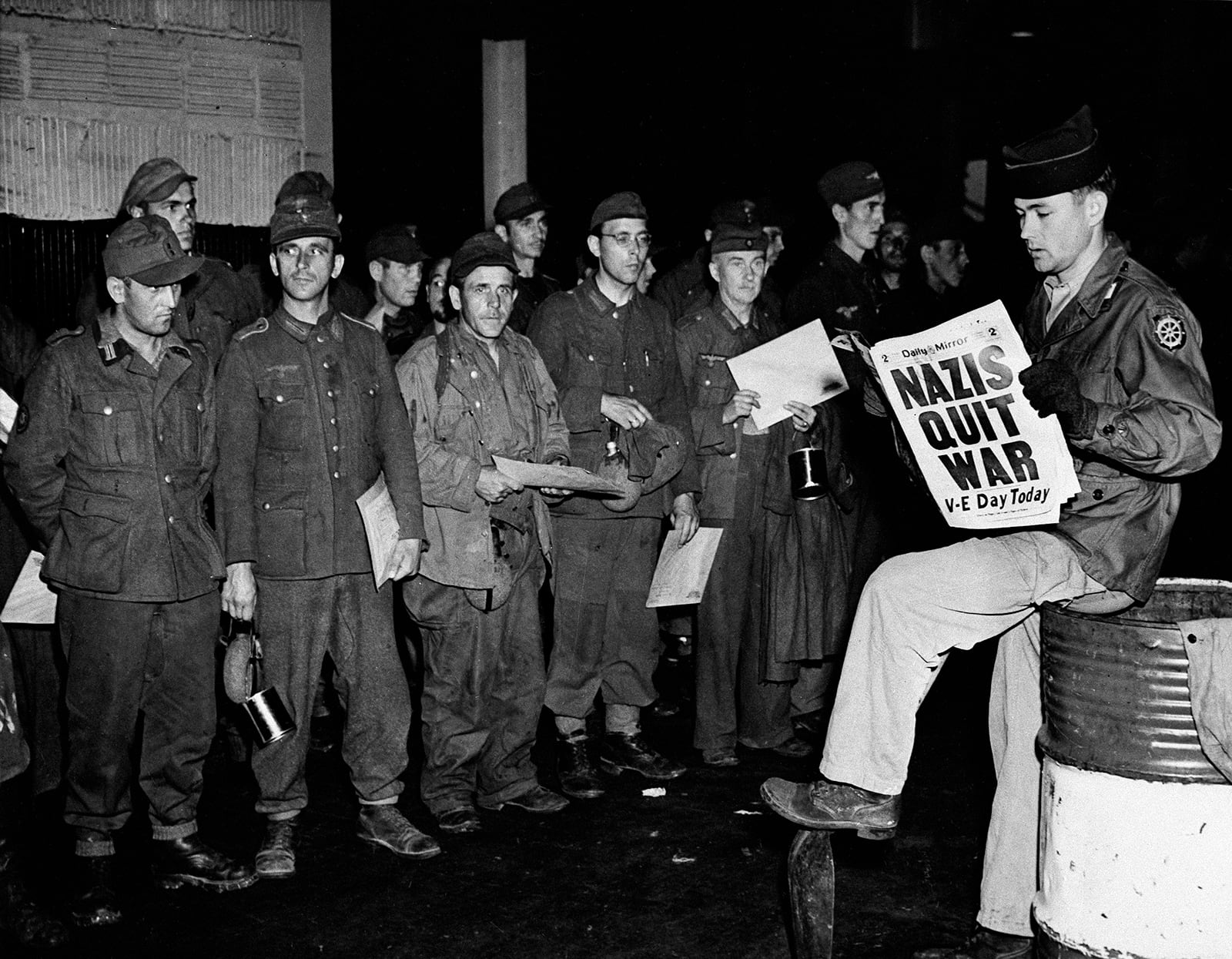
The Cincinnati Enquirer wrote in its May 8 morning edition, “After shadow boxing for a couple of weeks with rumors, news ‘scoops,’ and unconfirmed announcements, Cincinnati is expected to receive the official announcement of V-Day with a minimum of excitement.” President Truman’s announcement came “almost as a anticlimax after yesterday’s almost official announcement of victory.” Most of Cincinnati’s stores would close, but schools, the city’s stock exchange, and banks remained open, streetcars would operate normally. Most importantly, the majority of factories would continue to hum, producing war materiel, although a few declared a holiday or planned to close at noon. Continuing production was the theme of factories across America, and “absenteeism” was still unacceptable.
V-E Day 1945 in the Soviet Union
Western journalists had leaked word of the German capitulation on May 7, inducing Western nations to move up their official announcements. In the Soviet Union, Josef Stalin insisted on maintaining the agreed-upon schedule and make the announcement on May 9. A little after 1 a.m. on May 9, however, a radio reporter told those who were awake at that hour in the USSR that Nazi Germany had officially surrendered. As had happened elsewhere, impromptu celebrations broke out. In Red Square people sang, danced and kissed. A crowd gathered outside the U.S. embassy in Moscow, apparently to show gratitude for American Lend-Lease assistance during the war. Fireworks exploded over the Kremlin.
Stalin himself seemed less than enthusiastic. His deputy Nikita Khrushchev telephoned to congratulate the Soviet leader on his victory, and Stalin reportedly snapped at him, “Why are you bothering me? I am working.” The USSR’s official victory parade took place in a downpour over a month later, on June 24.
“Europe” was not placed after “Victory” for the Soviets’ Victory Day on May 9; it was simply Victory Day, marking the end of what they called the Great Patriotic War in which 25-30 million Soviet citizens had died, two-thirds of them civilians. One captain summed it up by saying, “Pora jit” (It’s time to live).
May 9 held no special significance, at least officially, between 1948 and 1964, but for the 20th anniversary in 1965 the day was declared a holiday, and a military parade took place in Red Square. Parades were held again in 1985 and 1990, after which they have been held annually. Flowers, with red carnations favored, are given to veterans in the streets.
V-E Day in the front lines of Europe
While soldiers, sailors and pilots in London and New York were dancing in the streets and stealing kisses from pretty girls, for the men in the front lines reaction was subdued. First Lieutenant William Lee Preston in the U.S. Third Army’s 65th Infantry Division wrote, “the front line troops didn’t celebrate. Most of the men merely read the story of victory from the division bulletin sent to the troops, said something like ‘I’m glad,’ and walked away. Perhaps it was a different story in their hearts, or perhaps they were too tired, or thinking of home too much, or thinking of their buddies who didn’t live to see the victory, to do much celebrating or merry making.” (Click here to read the complete text of Lt. Preston’s letter, as well as a letter by 22-year-old artist Lila whose USO duties included working with a sketching unit that visited recuperating soldiers in military hospitals.)
V-E Day in the Pacific Theater
Victory in Europe was welcome news to Allied troops in the Pacific and the China-Burma-India theaters of war. They greeted it with thanksgiving but there was little celebration. As a London Times special correspondent in Burma wrote, “The war is over. Let us get on with the war.” Now that Europe would no longer be receiving the bulk of troops and materiel, officers and enlisted personnel in the war against Japan hoped they would be given more men and equipment quickly, in order to end their war sooner.
Meanwhile, fighting continued in New Guinea, the Philippines, Okinawa, the CBI and elsewhere. Kamikazes still made suicide dives to sink Allied ships. The lights may have gone on over Europe and America, but a funereal pall still darkened the Pacific and Asia.
(Click here to read “The End of the Good War,” an account of American G.I.s in Europe during the final weeks prior to the German surrender.)
More from our partners at Historynet:
- ‘This Is What Hell Is Like’: 74 Years Ago, My Grandfather-in-Law Liberated the Dachau Concentration Camp
- The Incredible Six-Man Patrol Who Captured 32 POWs in a Single Day
- Conversation with Dick Cole, the Last of the Doolittle Raiders




